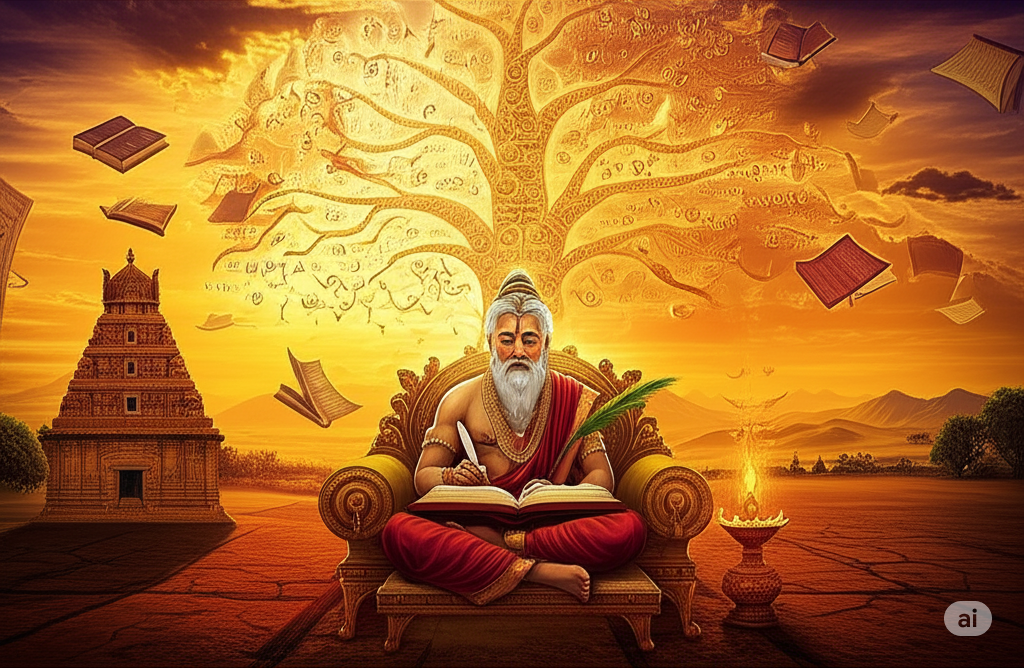அமைப்பியல் நோக்கில் தொல்காப்பியம்
A Structuralist perspective of Tolkappiyam
DOI:
https://doi.org/10.63300/kirjts0403202504Keywords:
Tolkappiyam, linguistic techniques, life traditions, politicsAbstract
Tolkappiyam has a long tradition in the history of Tamil grammar. Tolkappiyam did a great job of bringing all the ancient life and literary traditions of the Tamils to later times. In structuralism, a subject, an object or institution or anything about the political, social and economic system is examined in its components and its true nature and subtle rules would be pointed out. It is on this basis that the Russian structuralist Vladimir Prop examined Russian fairy tales and established that they consist of 31 components and that they have evolved into various stories. Similarly, the structuralist Levi Strauss established that binary oppositions play a major role in creating the world. The significant thing in this is that, like the principles of structuralism, Tolkappiyam also speaks of structure in another form. This study tries to establish that.
தொல்காப்பியம் தமிழ் இலக்கண வரலாற்றில் நெடிய பாரம்பரியம் கொண்டது. தமிழரின் பழைய வாழ்க்கை மரபுகள், நூல் மரபுகள் யாவற்றையும் பிற்பட்ட காலத்தவர்க்கு கொண்டு சேர்த்த பெருமை தொல்காப்பியத்திற்கே உண்டு. அமைப்பியலைப் பொறுத்தவரை ஒரு பொருள் அல்லது நிறுவனம் அல்லது அரசியல் சமூகப் பொருளாதாரம் குறித்த எதையும் கூறு கூறுகளாக ஆராய்ந்து அதன் உண்மை தன்மையை மற்றும் நுண்ணிய விதிகளைச் சுட்டிகாட்டும். இந்த அடிப்படையில் தான் ரஷ்ய அமைப்பியலாளரான விளாடிமிர் பிராப் ரஷ்யத் தேவதைக் கதைகளை ஆராய்ந்து அவை 31 கூறன்களைக் கொண்டவை என்றும் அவையே பல்வேறு கதைகளாகப் பரிணமித்துள்ளன என்றும் நிறுவிக்காட்டினார். அதுபோலவே லெவிஸ்ட்ராஸ் என்ற அமைப்பியல் ஆய்வாளர் எதிரிணைகள் உலகை உருவாக்கியதில் மிகுந்த பங்கு கொண்டவை என்பதை நிறுவிக் காட்டினார். இதில் குறிப்பிடத்தக்க செய்தி என்னவென்றால் அமைப்பியல் கோட்பாடுகளைப் போலவே தொல்காப்பியமும் இன்னொரு வடிவத்தில் அமைப்பியலைப் பேசுகின்றது என்பதுதான். அதனை நிறுவிக் காட்டும் நிலையில் அமைகிறது இந்த ஆய்வு.
Downloads
References
1. Nadarasan.T.S., Thiranaivukalai kolgaikalum anugumuraigalum, New century Book House, Chennai, 2016.
2. Panchangam.K, Illakkiyamum Thiranaivuk kotpaduKalum,Annam-agaram publication, Thanjavur, 2016.
3. Thamizhavan,pazhanthamizhil amaipiyal matrum kuriyiyal Aaivugal,Ulaga Tamizh Aaraichi Niruvanam,சென்னை, 2019.
4. Thamizhavan, Amaipiyalum adhan piragum, Adayalam publication, Trichy, 2019.
5. Steephen.G,Amaipiyal kotpadum Aaiyvukalum ,New century Book House, Chennai, 2013.
6. Poornachandran.K, Amaipiyamum pin Amaipiyamum, Adayalam publication, Trichy, 2009.
7. Yaroslaw Wachak, Sanga Illakiyathil Eyarkkai kuriyeedu, Adyalam publication,Trichy, 2015.
8. Balasundaram.S, Tholkappiyam Aarayichi kaandigai urai Part-1,2,3, Periyar University, Salem, 2012.
1. நடராசன். தி.சு., திறனாய்வு கலைக் கொள்கைகளும் அணுகுமுறைகளும், நியூ செஞ்சுரி புக் ஹவுஸ், சென்னை, 2016.
2. பஞ்சாங்கம். க., இலக்கியமும் திறனாய்வுக் கோட்பாடுகளும், அன்னம் -அகரம் வெளியீடு, தஞ்சாவூர், 2016.
3. தமிழவன், பழந்தமிழில் அமைப்பியல் மற்றும் குறியியல் ஆய்வுகள், உலகத் தமிழாராய்ச்சி நிறுவனம், சென்னை, 2009.
4. தமிழவன், அமைப்பியலும் அதன் பிறகும், அடையாளம் பதிப்பகம், திருச்சி, 2019.
5. ஸ்டீபன் .ஞா., அமைப்பில் கோட்பாடும் ஆய்வுகளும் ,நியூ செஞ்சுரி புக் ஹவுஸ், சென்னை, 2013.
6. பூரணச்சந்திரன் க., அமைப்பியமும் பின் அமைப்பியமும், அடையாளம் பதிப்பகம் ,திருச்சி, 2009.
7. யரோஸ்லவ் வாச்சக், சங்க இலக்கியத்தில் இயற்கை குறியீடு ஐந்திணை மலர்களும் மரபுகளும், அடையாளம் பதிப்பகம், திருச்சி, 2015 .
8. பாலசுந்தரம் .ச., தொல்காப்பியம் ஆராய்ச்சி காண்டிகையுரை .(தொகுதி- 1, தொகுதி- 2, தொகுதி- 3, பகுதி -3), பெரியார் பல்கலைக்கழகம், சேலம், 2012.

Downloads
Published
Issue
Section
License
Copyright (c) 2025 செ. யமுனா (Author)

This work is licensed under a Creative Commons Attribution 4.0 International License.
Our journal adopts CC BY License Creative Commons Attribution 4.0 International License http://Creativecommons.org//license/by/4.0/ . It allows using, reusing, distributing and reproducing of the original work with proper citation.





